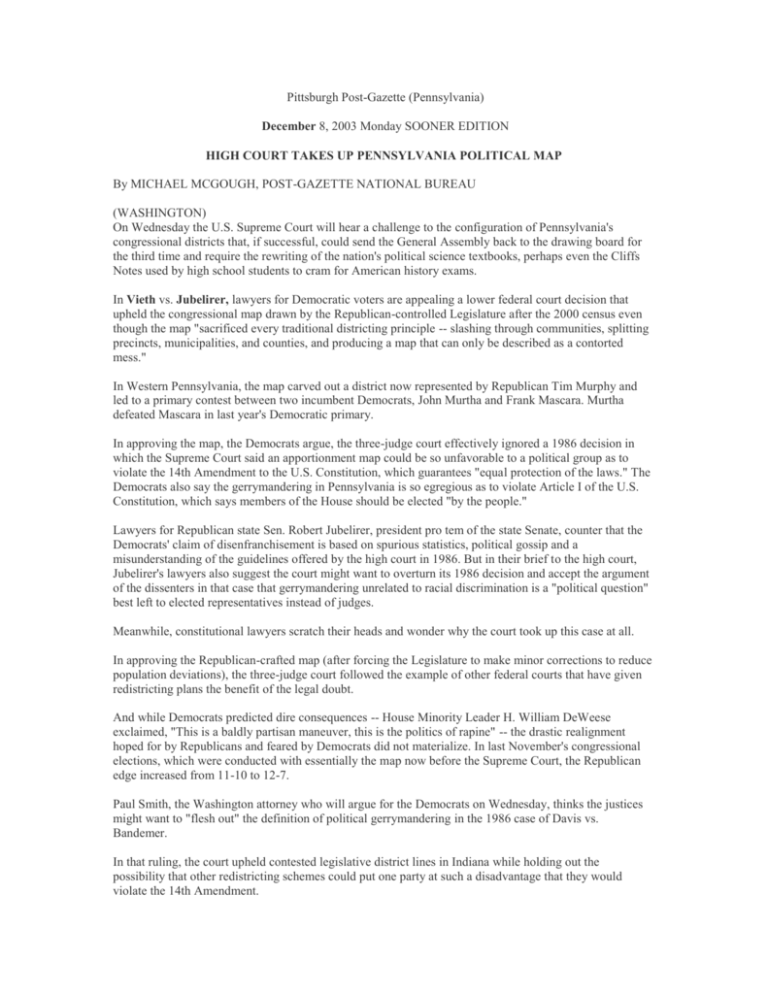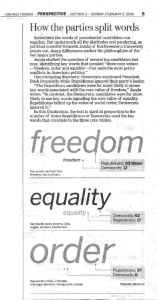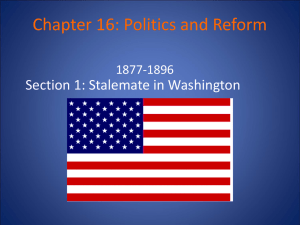High Court takes up Pennsylvania political map
advertisement

Pittsburgh Post-Gazette (Pennsylvania) December 8, 2003 Monday SOONER EDITION HIGH COURT TAKES UP PENNSYLVANIA POLITICAL MAP By MICHAEL MCGOUGH, POST-GAZETTE NATIONAL BUREAU (WASHINGTON) On Wednesday the U.S. Supreme Court will hear a challenge to the configuration of Pennsylvania's congressional districts that, if successful, could send the General Assembly back to the drawing board for the third time and require the rewriting of the nation's political science textbooks, perhaps even the Cliffs Notes used by high school students to cram for American history exams. In Vieth vs. Jubelirer, lawyers for Democratic voters are appealing a lower federal court decision that upheld the congressional map drawn by the Republican-controlled Legislature after the 2000 census even though the map "sacrificed every traditional districting principle -- slashing through communities, splitting precincts, municipalities, and counties, and producing a map that can only be described as a contorted mess." In Western Pennsylvania, the map carved out a district now represented by Republican Tim Murphy and led to a primary contest between two incumbent Democrats, John Murtha and Frank Mascara. Murtha defeated Mascara in last year's Democratic primary. In approving the map, the Democrats argue, the three-judge court effectively ignored a 1986 decision in which the Supreme Court said an apportionment map could be so unfavorable to a political group as to violate the 14th Amendment to the U.S. Constitution, which guarantees "equal protection of the laws." The Democrats also say the gerrymandering in Pennsylvania is so egregious as to violate Article I of the U.S. Constitution, which says members of the House should be elected "by the people." Lawyers for Republican state Sen. Robert Jubelirer, president pro tem of the state Senate, counter that the Democrats' claim of disenfranchisement is based on spurious statistics, political gossip and a misunderstanding of the guidelines offered by the high court in 1986. But in their brief to the high court, Jubelirer's lawyers also suggest the court might want to overturn its 1986 decision and accept the argument of the dissenters in that case that gerrymandering unrelated to racial discrimination is a "political question" best left to elected representatives instead of judges. Meanwhile, constitutional lawyers scratch their heads and wonder why the court took up this case at all. In approving the Republican-crafted map (after forcing the Legislature to make minor corrections to reduce population deviations), the three-judge court followed the example of other federal courts that have given redistricting plans the benefit of the legal doubt. And while Democrats predicted dire consequences -- House Minority Leader H. William DeWeese exclaimed, "This is a baldly partisan maneuver, this is the politics of rapine" -- the drastic realignment hoped for by Republicans and feared by Democrats did not materialize. In last November's congressional elections, which were conducted with essentially the map now before the Supreme Court, the Republican edge increased from 11-10 to 12-7. Paul Smith, the Washington attorney who will argue for the Democrats on Wednesday, thinks the justices might want to "flesh out" the definition of political gerrymandering in the 1986 case of Davis vs. Bandemer. In that ruling, the court upheld contested legislative district lines in Indiana while holding out the possibility that other redistricting schemes could put one party at such a disadvantage that they would violate the 14th Amendment. Republicans in Harrisburg take heart from a different scenario: that after 17 years the court thinks it made a mistake in 1986 and that dissenting Justice Sandra Day O'Connor was right when she warned that "the partisan gerrymandering claims of major political parties raise a nonjusticiable political question that the judiciary should leave to the legislative branch as the Framers of the Constitution unquestionably intended." O'Connor's view has considerable historical support. It was in 1812 that Gov. Elbridge Gerry of Massachusetts approved a salamander-shaped congressional district that critics called a "gerrymander." And until the 1960s it was the conventional wisdom that state legislatures even had the power to devise districts that differed dramatically in population. That sort of mathematical malapportionment ended when the Supreme Court promulgated the "one person, one vote" rule. "One person, one vote" is an easy standard for courts to apply, especially in the computer age. A more difficult inquiry is whether a map is drawn to disenfranchise racial groups, a responsibility that the courts have undertaken because of the importance of racial justice in the political process. But allegations of partisan gerrymandering have proved to be the most puzzling of all for judges since the Supreme Court's 1986 ruling in the Indiana case. Lower courts have reacted by holding their noses and approving maps. The problem may be with the 1986 decision. In the leading opinion in that case, the late Justice Byron White said political gerrymanders could be subject to constitutional challenge only if they led to a long-term marginalizing of an identifiable group. "Unconstitutional discrimination occurs only when the electoral system is arranged in a manner that will consistently degrade a voter's or a group of voters' influence on the political process as a whole," White wrote. White also rejected any claim that "legislatures in reapportioning must draw district lines to come as near as possible to allocating seats to the contending parties in proportion to what their anticipated statewide vote will be." Under the standard as it has been applied in the Pennsylvania case, Duquesne University law professor Ken Gormley said, "If you were able to craft a districting plan under which a party comprised 50 percent of the electorate but couldn't elect a single representative, that would be OK." To guard against such a distortion, Democrats are urging the Supreme Court to give partisan gerrymandering the same sort of scrutiny it imposes on racial gerrymandering. And while the Democrats doesn't ask the court to require proportional representation, their brief says: "Any party that earns a majority of the vote should have at least a fighting chance to become the governing party, with a majority of seats." In their brief, lawyers for Jubelirer and the Republicans ridicule as simplistic the notion that Democrats or Republicans are an "identifiable group" and allude to the fact that many voters split their tickets. Citing the 2000 federal election, their brief notes that voters in six districts supported both Democratic presidential nominee Al Gore and Republican U.S. Rick Santorum. "Are Appellants the Santorum Democrats or the Gore Democrats?" the brief asks. NOTES: Michael McGough can be reached at mmcgough@nationalpress.com or 1-202-662-7025. GRAPHIC: MAP: Post-Gazette; www.mc.org/media/pdfs/pa_cd__post.pdf: (Pa. congressional districts)








